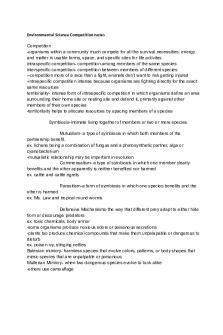Notes - Managing Competition and Conflict PDF

| Title | Notes - Managing Competition and Conflict |
|---|---|
| Author | Sarah Wang |
| Course | Public Relations |
| Institution | University of California Davis |
| Pages | 4 |
| File Size | 100.4 KB |
| File Type | |
| Total Downloads | 25 |
| Total Views | 138 |
Summary
Professor Heather Hether...
Description
Chapter 8: Managing Competition and Conflict -Public relations can be defined as the strategic management of competition and conflict -Strategic conflict management
Conflict is inherent in public relations process PR professionals must develop communication strategies to manage the conflict
The Threat Appraisal Model -PR professionals monitor for threats, assess threats, arrive at a desirable stance for the org, and then begin communications efforts from that stance
Situational demands Resources
-stance-driven approach in managing conflict
External and internal variables stance strategy
Contingency Theory -Contingency factors
A matrix of factors drive the stance
-The contingency continuum
Stance is dynamic; changes as events do Ex. President Clinton
Conflict Management Life Cycle -Four systematic processes that overlap with the life cycle of conflict
1. Issues management (proactive) 2. Strategic positioning and risk communication (strategic) 3. Crisis management (reactive) 4. Reputation management (Recovery)
-Proactive Phase
To prevent a conflict from arising o Environmental scanning o Issues tracking o Issues management o Crisis planning (I) Issues management o Predict problems
o o o o
Anticipate threats Minimize surprises Resolve issues Prevent crises
-Strategic Phase
Emerging conflict is identified as needing action o Risk communication o Conflict positioning strategies o Crisis management plan (II) Strategic positioning and risk communication o Communication efforts to position the organization favorably regarding competition and conflict o An attempt to communicate risks to the public that impact health, safety, and the environment
-Reactive Phase
Must react when conflict reaches a critical level of impact o Crisis communication o Conflict resolution techniques o Litigation public relations (III) Crisis Management o 86% of business crises were “smoldering crises” o Start out slow and builds o Coombs’ crisis communication strategies o Attack the accuser o Denial o Excuse o Justification o Ingratiation o Corrective action o Full apology
-Recovery Phase
Strategies employed aftermath to bolster or repair reputation o Reputation management o Image restoration strategies (IV) Reputation Management & Image Restoration o Strategies include denial o Evading responsibility o Reducing offensiveness
o o
Corrective action mortification
What is a crisis? -a major event that has potentially negative results -may significantly damage an organization and its employees, products, services, financial condition, and reputation -represents a turning point for the organization -Problem or Crisis? -Problems: commonplace; predictable; quickly resolved; and may go unnoticed -Crises: less predictable; more time-consuming; costly; and bring unwanted public attention -Crises run the risk of
escalating in intensity falling under close scrutiny interfering with operations jeopardizing image damaging the bottom line
-Crisis management
How an organization manages its response to a crisis o Can’t control external environment
-Crisis response
Response depends upon o Public and political environment o Culture and inner workings of the org o People and groups involved
-Four basic causes
Act of god Mechanical problems Human error Management decisions, actions, inaction
-Crisis management goals
1. Terminate the crisis quickly 2. Limit damage
3. Restore credibility...
Similar Free PDFs

Notes on Competition Act
- 29 Pages

Lecture notes perfect competition
- 10 Pages

Competition LAW Notes -
- 57 Pages

Competition Reading and Cases
- 23 Pages

Conflict management notes
- 48 Pages

Managing Employees Relations Notes
- 15 Pages

Conflict Theory Textbook Notes
- 3 Pages

13 Protectionism and Competition
- 2 Pages
Popular Institutions
- Tinajero National High School - Annex
- Politeknik Caltex Riau
- Yokohama City University
- SGT University
- University of Al-Qadisiyah
- Divine Word College of Vigan
- Techniek College Rotterdam
- Universidade de Santiago
- Universiti Teknologi MARA Cawangan Johor Kampus Pasir Gudang
- Poltekkes Kemenkes Yogyakarta
- Baguio City National High School
- Colegio san marcos
- preparatoria uno
- Centro de Bachillerato Tecnológico Industrial y de Servicios No. 107
- Dalian Maritime University
- Quang Trung Secondary School
- Colegio Tecnológico en Informática
- Corporación Regional de Educación Superior
- Grupo CEDVA
- Dar Al Uloom University
- Centro de Estudios Preuniversitarios de la Universidad Nacional de Ingeniería
- 上智大学
- Aakash International School, Nuna Majara
- San Felipe Neri Catholic School
- Kang Chiao International School - New Taipei City
- Misamis Occidental National High School
- Institución Educativa Escuela Normal Juan Ladrilleros
- Kolehiyo ng Pantukan
- Batanes State College
- Instituto Continental
- Sekolah Menengah Kejuruan Kesehatan Kaltara (Tarakan)
- Colegio de La Inmaculada Concepcion - Cebu







